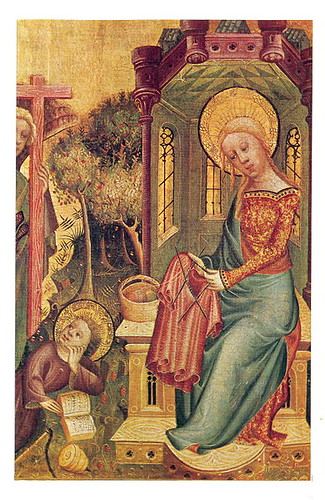Please, behold this religious image of the Virgin Mary knitting:

Now, please examine the following text from the introduction of The Knitting Man(ual), by Kristin Spurkland:
"People across Europe were employed in the knitting cottage industry, primarily outputting socks and stockings for the wealthy classes. (para) Surprisingly, these early knitting professionals were unquestionably men. In the beginning, knitting was a strictly male endeavor, and remained so until the Industrial Revolution mechanized production. While both men and women followed knitting into the factories, hand-knitting at home began its transformation into a feminine art..."
I call bullshit. Moreover, I call bullshit on five key points:
Firstly, the Virgin is not admiring her boyfriend's knitting in the above-featured 15th century altarpiece panel by the Master Bertram. The creation of this painting rather pre-dates the Industrial Revolution, as do many other depictions of women knitting.
Secondly, both men and women have knit since, well, the dawn of knitting, although who knit what and why varies depending on era and country. Sailors and goatherds, and others who spent a lot of time waiting and watching (soldiers in the trenches I'm not supposed to talk about) often knit. As did women who had a lot of other things to do with their time, but also needed to clothe their families.
Thirdly, the author seems to have confused cottage industries with knitting guilds, which for several centuries (like most official professions) employed only men. Cottage industry often employed whole families; everyone from toddlers old enough to sort colored thread and buttons to grandparents would take part.
Fourthly, a case study: the early Lowell's textile mills in America. When the mills first started, they tried to hire almost exclusively young, single women from rural backgrounds. The idea is that women could be paid less than men, and women isolated from their families were less likely to make a fuss about wages or hours. And, when mills were rare and the wages comparatively high, it's true that they didn't. That didn't last long. I encourage you to google Lowell's mill women. When men and women did work in factories, the work tended to be gender segregated.
Fifthly... "began its transformation into a feminine art"?! Not only is that patently inaccurate, but it paints a very Victorian middle-upper upper-class picture, with women only knitting christening gowns and dainty gloves... because knitting practical garments like socks would indicate that one needed to work for a living. Spurkland's introduction ignores the realities of knitting, and trivializes women's history with it in the interest of making it appealing to men again.
Pant. Pant. Sigh.
By contrast, review the following brief excerpt from Michael del Vecchio's introduction to Knitting With Balls:
"People knit because they were poor (and cold) and the politics of gender had little to do with it."
What a nice and concise way to briefly acknowledge the nature of knitting without needed to give people a wildly inaccurate history lesson. I approve.
And to think, this came about because I wanted to tell people about some of the devices I like to see in knitting books. Maybe later.



3 comments:
Man, I agree with you all over the place. You're such a great nerd.
I'm a casual history buff, and had often wondered about the beginning of knitting. Up until recently the warliest references I stumbled across were all about Elizabeth I's silk stockings... Lately though, thanks to Ravelry, I've seen that knitting goes back at least to ancient Egypt. Pretty nifty!
Even with my limited expertise, I cringe and rant when I see glaringly painful inaccuracies. Good to see someone else does too.
Thanks for a great rant! I do love it when someone counters sloppy thinking with such precision.
Post a Comment